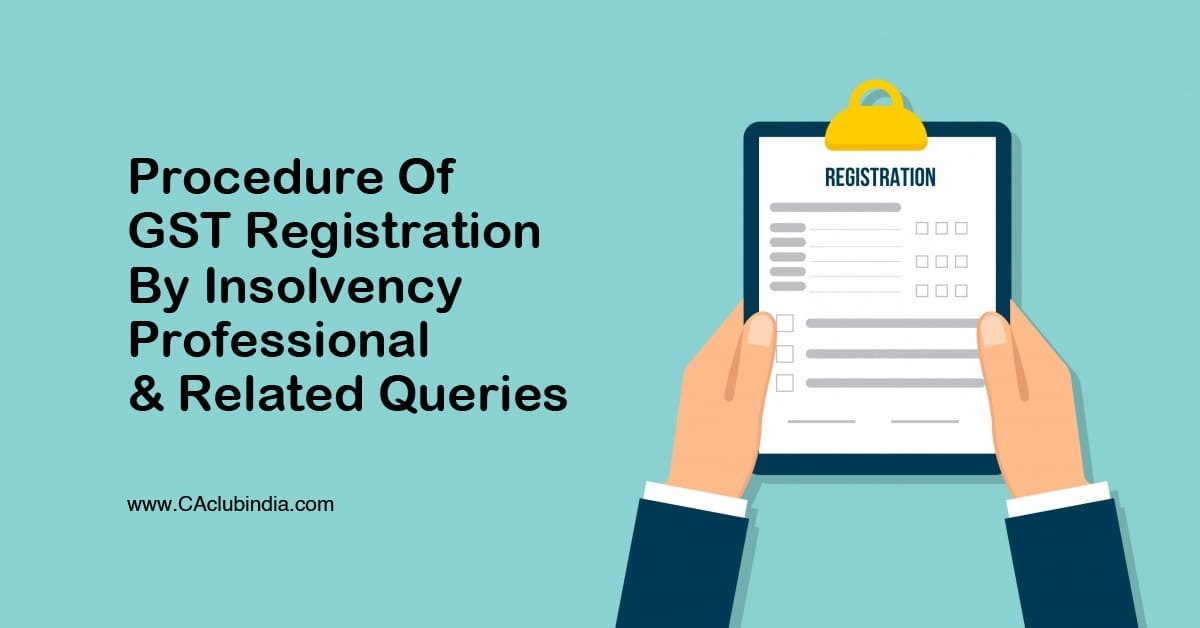The Central Goods & Services Tax Act 2017, or CGST Act 2017, is a law that allowed the government to introduce guidelines for all the GST related queries and topics in the past at the time when they were first introduced in India in 2017. It is since being used to add more rules & regulations when needed through this act. Under Rule 148 under this act, a special procedure has been laid down by the government through Notification No. 11/2020- Central Tax, which was dated 21/03/2020. It says that every Interim Resolution Professional (IRP) or Resolution Professional (RP) needs to mandatorily apply for a fresh new registration application under GST for each of the states where the registration process for the corporate debtor has been done within a period of 30 days before the date of appointment or if his appointment has already been done before his date of appointment and notification, the corporate debtor has to apply for the fresh registration procedure within 30 days of the date of this notification.
This was then later removed as per Notification No. 39/2020- Central Tax, which was dated as 05/05/2020. In other words, there is no need for the fresh application procedure for the GST registration to be followed but only if the corporate debtor has already filed the returns prescribed under Rule 37 & 39 of the CGST Act, 2017 for all the tax periods prior to the appointment of IRP or RP.
The government recently brought Circular No. 134/04/2020 & Circular No. 138/08/2020 and in doing so introduced some clarifications concerning the notifications which were mentioned previously above. Let’s take a look at these queries & their respective clarifications introduced through these circulars:
1. How are the dues of the pre-CIRP period be dealt & is the IRP or RP liable for the GST compliances for that period?
- The dues for the period prior to the commencement of the CIRP (Corporate Insolvency Resolution Process) will be treated as an “Operational Debt” and the claims are allowed to be filed by the officer before the NCLT (National Company Law Tribunal) for the same. As for the part of the question, no, neither the IRP nor the RP is liable for the GST compliances and are not needed to file any returns for that pre-CIRP period.

2. What happens with the already existing GSTIN of the corporate debtor?
- If need be, the officer may suspend the registration which will debar the corporate debtor from making any taxable supply on his existing GSTIN (Goods and Services Tax Identification Number) & then will also need not to file any of the returns prescribed under the CGST Act, 2017. If that’s not the case, then the existing registration will not be cancelled.
3. Is the IRP or the IP required to comply for the period from his date of appointment till the date of the new registration granted?
- Yes. The IRP or the IP (Insolvency Professional) is required to ensure that he needs to file the return & comply with the provisions of the GST law after obtaining the new registration and for the period beginning the date on which he became liable to take the registration till the date on which registration has been granted by filing the first return as prescribed under the Rule 40 of the CGST Act, 2017.
4. Is the IRP or the IP eligible to claim ITC for all the invoices of the period post his appointment as IRP or IP & before the date of this Notification No. 11/2020- Central Tax, which was dated as 21/03/2020, and whether he is eligible to claim the refund of the amount which was deposited in Electronic cash ledger for the said period?
- As understood from the clarification of query no. 3, while filing for his first return under Rule 40 of the CGST Act, 2017, he is eligible to claim the ITC for all those invoices as well which is bearing the GSTIN of the person registered earlier before by overlooking the ITC limitations prescribed under Rule 16 Section 4 & Rule 36 Section 4 of the CGST Act. And any amount which was deposited by the IRP or the RP in the said period in the cash ledger of the earlier GSTIN is also eligible for filing a refund under the GST law & the condition of filing of all the pending returns for claiming the refund under normal provisions has also been given out properly.
5. What will happen if the IRP or the IP who was appointed earlier but was then later on replaced by the RP after obtaining the new GST registration?
- There is no need for the new GST registration to be done & the same can be done by filing an amendment of the non-core field in the GST registration by replacing the IRP who was appointed earlier as a primary authorised signatory with the new RP as the new primary authorised signatory. And hence, the only change needed is in the position of an authorised signatory is which can be done either by the concerned jurisdictional officer or by the company’s authorised signatory on the request by the IRP or the IP.
And these were the queries that were clarified when the government introduced Circular No. 134/04/2020 & Circular No. 138/08/2020. Whenever things are updated or improved, more questions arise from those and that’s why questions are rising that need some clarification and thus why these queries are really important to be clarified. So, when in the future there are more updates in the act, there might be more queries that come up and need to clarify similarly. And thus concludes the procedure by GST registration insolvency professional and the queries related to it.








 CAclubindia
CAclubindia

